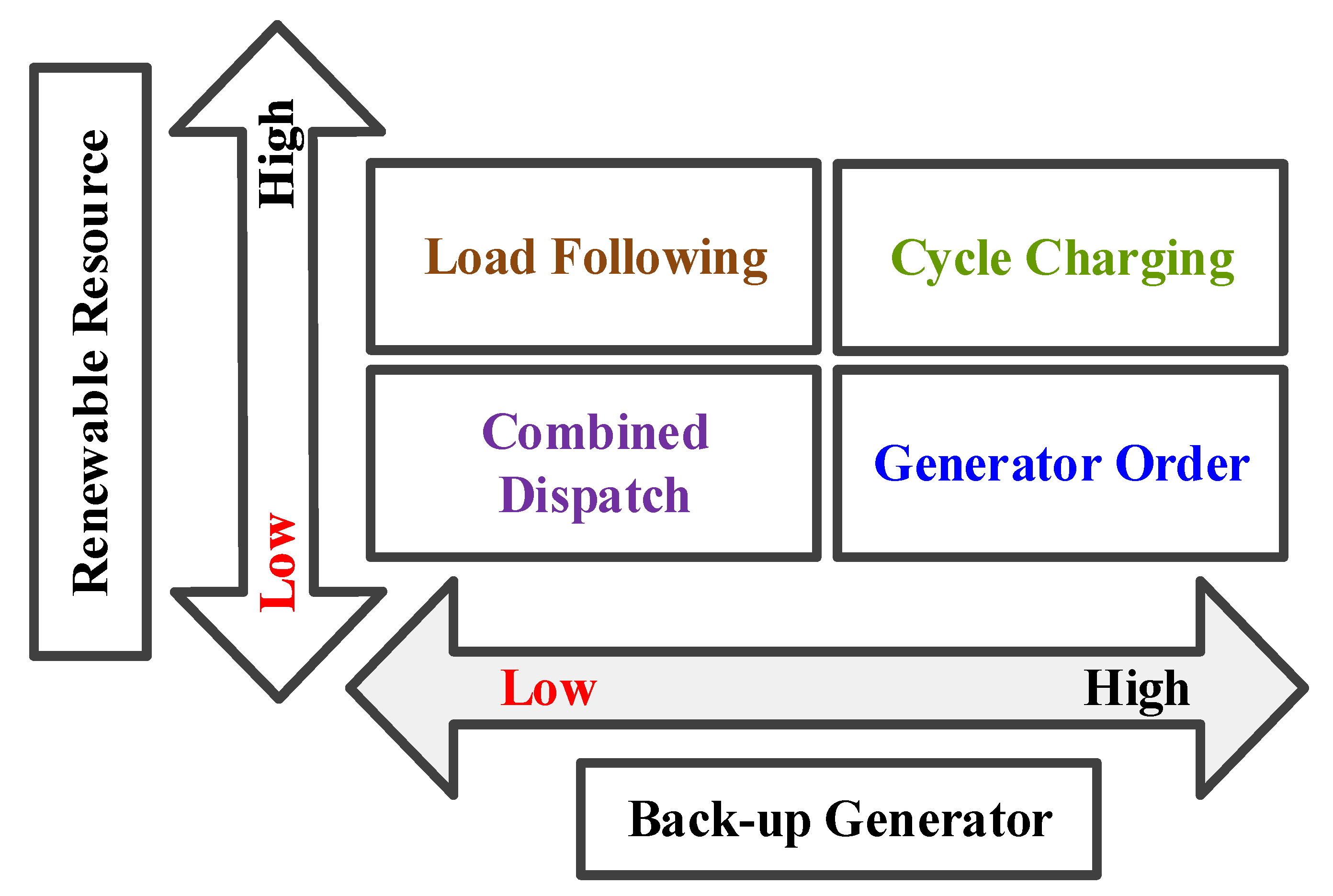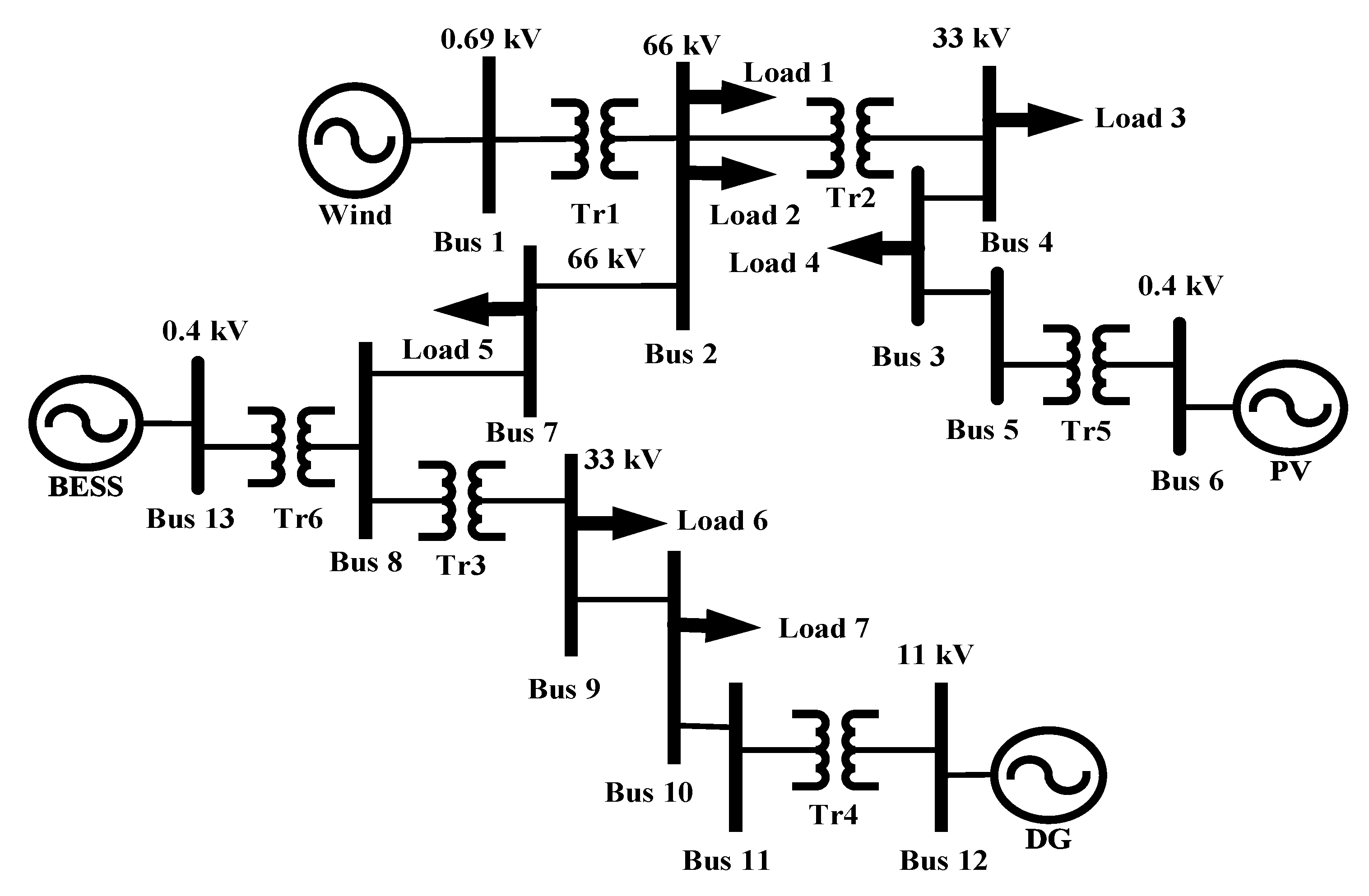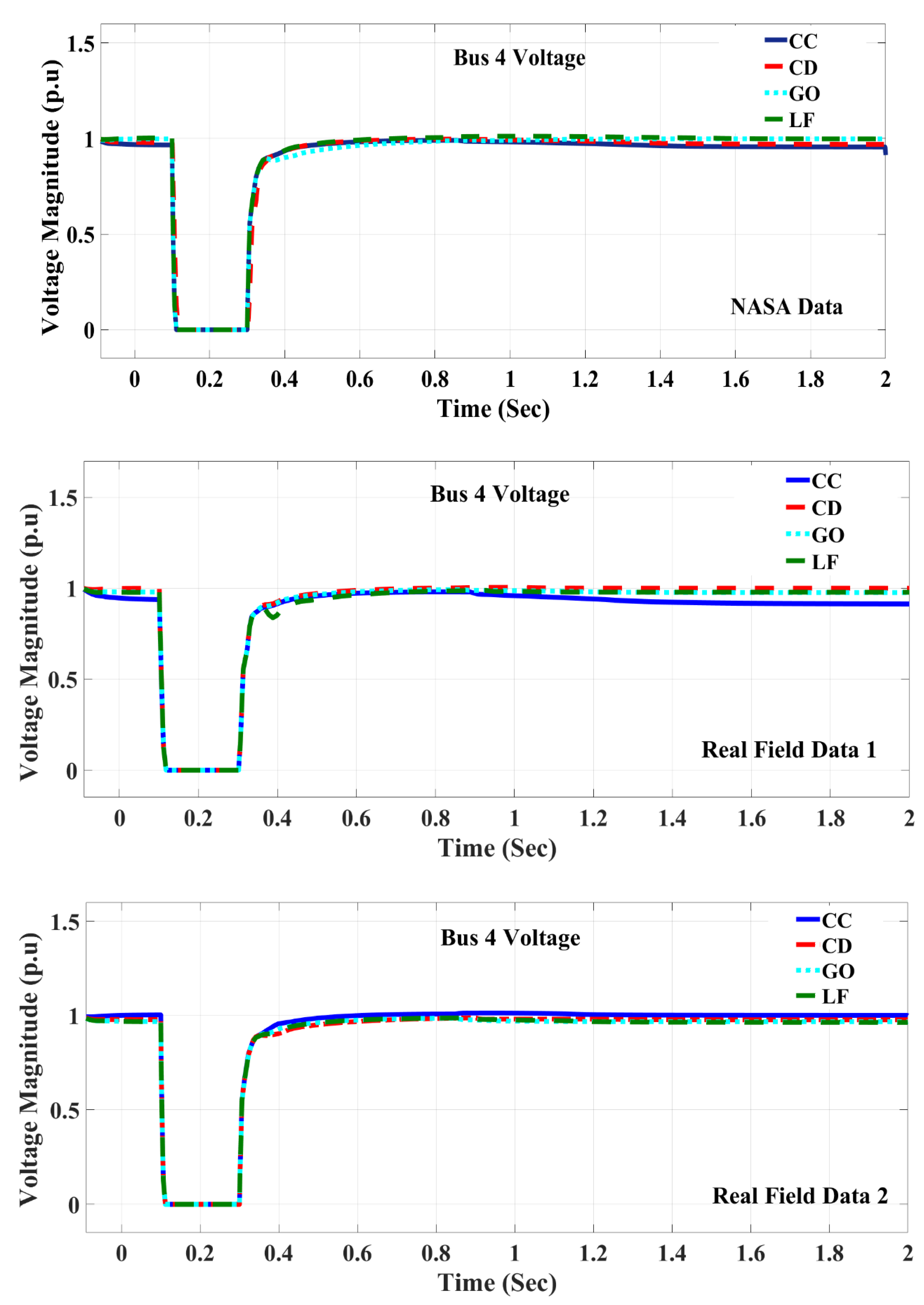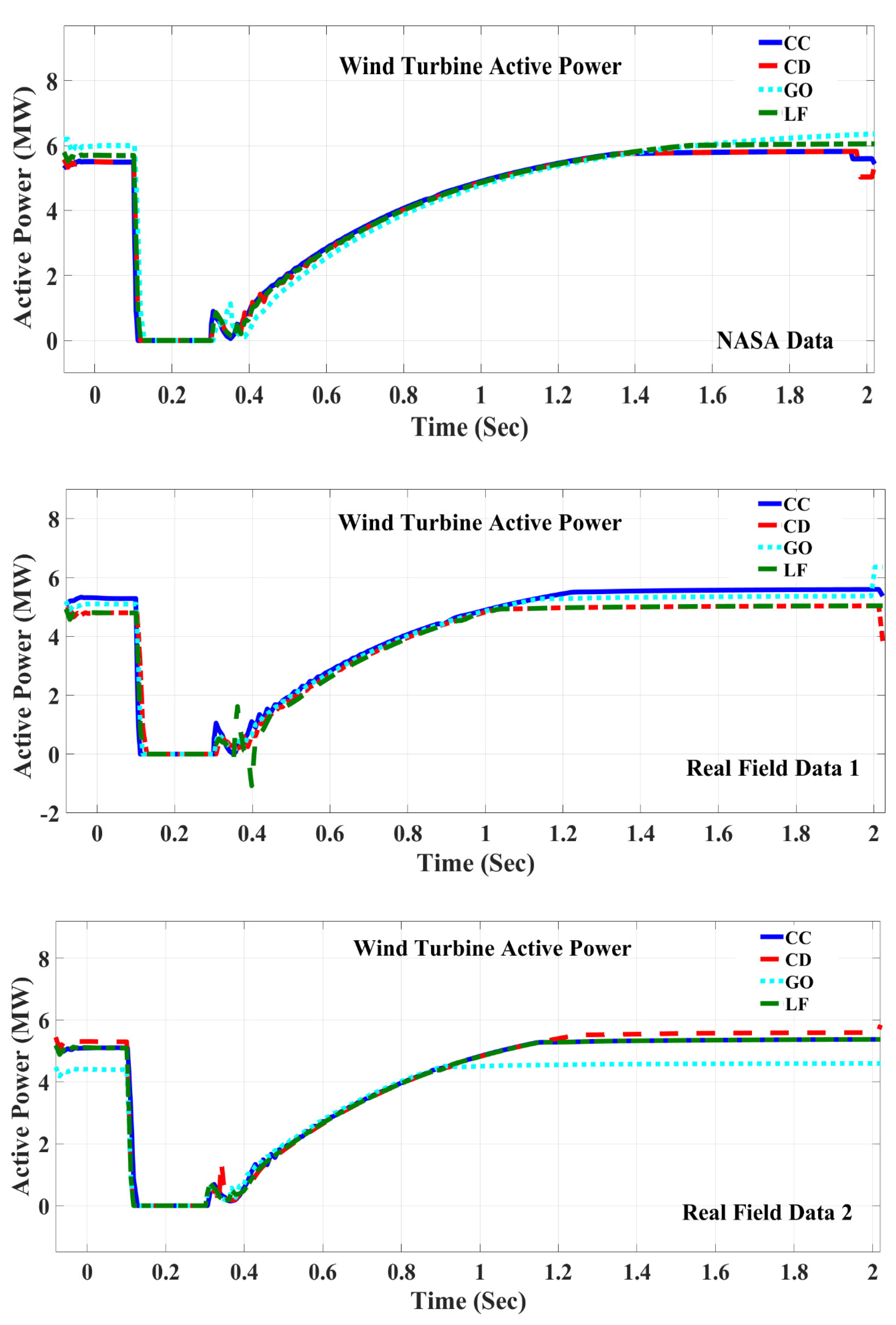Selection of Appropriate Dispatch Strategies for Effective Planning and Operation of a Microgrid
Abstract
:1. Introduction
1.1. Review of Dispatch Strategies and Optimization Applied to Microgrids
1.2. Review of System Operation (Stability) Issues in Microgrids
1.3. Review of System Planning (Reliability) Issues in Microgrids
1.4. Research Gaps Identified in Microgrid Optimization for Efficient Planning and Operation
- Lack of coordination between optimal sizing and techno-economic analysis.
- Lack of coordination between techno-economic analysis and power system performances.
- The comparative analysis of dispatch strategies for the IHMS in terms of combined research of techno-economic analysis and power system performances are missing.
- The reliability analysis of the IHMS has never been considered under the dispatch strategies domain to ensure the technical feasibility of the system.
1.5. Contributions of This Research and Paper Outline
- To begin, choose the most appropriate dispatch method (in the HOMER software platform) to determine the optimal sizing of the resources of an islanded hybrid microgrid in order to achieve the lowest cost of energy (COE), net present cost (NPC), and CO2 emissions;
- Second, by analyzing the power system performance, ensure efficient, stable, and reliable operation of the best microgrid design (as determined in the previous stage) in MATLAB/Simulink and DIgSILENT PowerFactory.
2. Research Methodology
2.1. System Simulation Procedure
2.2. Dispatch Strategies
2.3. Microgrid Topology
2.4. Optimization Equations
2.5. Test Microgrid
2.6. System Simulation Scenarios
- (1)
- (2)
- (3)
2.7. Reliability Indices
3. Results and Discussion
3.1. Optimal Sizing
3.2. Power System Reliability Assessment
3.3. Power System Voltage and Frequency Assessment
3.4. Power System Real and Reactive Power Assessment
3.5. Comparative Analysis with Other Power and Energy Systems
3.5.1. Comparative Analysis of Designed System
3.5.2. Best and Worst Dispatch Strategy
3.5.3. Applications and Implementations of This Research Work
4. Conclusions
Author Contributions
Funding
Institutional Review Board Statement
Informed Consent Statement
Data Availability Statement
Acknowledgments
Conflicts of Interest
References
- Letcher, T.M. Introduction with a Focus on Atmospheric Carbon Dioxide and Climate Change. In Future Energy; Elsevier: Amsterdam, The Netherlands, 2020; pp. 3–17. [Google Scholar] [CrossRef]
- Shezan, S.A.; Saidur, R.; Ullah, K.; Hossain, A.B.M.S.; Chong, W.T.; Julai, S. Feasibility analysis of a hybrid off-grid wind–DG-battery energy system for the eco-tourism remote areas. Clean Technol. Environ. Policy 2015, 17, 2417–2430. [Google Scholar] [CrossRef]
- Liu, B.; Liu, S.; Guo, S.; Zhang, S. Economic study of a large-scale renewable hydrogen application utilizing surplus renewable energy and natural gas pipeline transportation in China. Int. J. Hydrog. Energy 2020, 45, 1385–1398. [Google Scholar] [CrossRef]
- Liu, W.; Zhuang, P.; Liang, H.; Peng, J. Distributed Economic Dispatch in Microgrids Based on Cooperative Reinforcement Learning. IEEE Trans. Neural Netw. Learn. Syst. 2018, 29, 2192–2203. [Google Scholar] [CrossRef]
- Chen, F.; Chen, M.; Xu, Z.; Guerrero, J.M.; Wang, L.Y. Distributed noise-resilient economic dispatch strategy for islanded microgrids. IET Gener. Transm. Distrib. 2019, 13, 3029–3039. [Google Scholar] [CrossRef]
- Ju, C.; Wang, P.; Goel, L.; Xu, Y. A Two-Layer Energy Management System for Microgrids with Hybrid Energy Storage Considering Degradation Costs. IEEE Trans. Smart Grid 2017, 9, 6047–6057. [Google Scholar] [CrossRef]
- Liu, T.; Tan, X.; Sun, B.; Wu, Y.; Tsang, D.H. Energy management of cooperative microgrids: A distributed optimization approach. Int. J. Electr. Power Energy Syst. 2018, 96, 335–346. [Google Scholar] [CrossRef]
- Abdullah, A.; Muttaqi, K.M.; Sutanto, D.; Agalgaonkar, A. An Effective Power Dispatch Control Strategy to Improve Generation Schedulability and Supply Reliability of a Wind Farm Using a Battery Energy Storage System. IEEE Trans. Sustain. Energy 2014, 6, 1093–1102. [Google Scholar] [CrossRef]
- Zhao, B.; Xue, M.; Zhang, X.; Wang, C.; Zhao, J. An MAS based energy management system for a stand-alone microgrid at high altitude. Appl. Energy 2015, 143, 251–261. [Google Scholar] [CrossRef] [Green Version]
- Qadrdan, M.; Wu, J.; Jenkins, N.; Ekanayake, J. Operating Strategies for a GB Integrated Gas and Electricity Network Considering the Uncertainty in Wind Power Forecasts. IEEE Trans. Sustain. Energy 2013, 5, 128–138. [Google Scholar] [CrossRef]
- Zhang, Y.; Gatsis, N.; Giannakis, G. Robust Energy Management for Microgrids with High-Penetration Renewables. IEEE Trans. Sustain. Energy 2013, 4, 944–953. [Google Scholar] [CrossRef] [Green Version]
- Ye, L.; Zhang, C.; Tang, Y.; Zhong, W.; Zhao, Y.; Lu, P.; Zhai, B.; Lan, H.; Li, Z. Hierarchical model predictive control strategy based on dynamic active power dispatch for wind power cluster integration. IEEE Trans. Power Syst. 2019, 34, 4617–4629. [Google Scholar] [CrossRef]
- Wen, Y.; Chung, C.Y.; Liu, X.; Che, L. Microgrid Dispatch with Frequency-Aware Islanding Constraints. IEEE Trans. Power Syst. 2019, 34, 2465–2468. [Google Scholar] [CrossRef]
- Vergara, P.P.; Rey, J.M.; Shaker, H.R.; Guerrero, J.M.; Jørgensen, B.N.; Da Silva, L.C. Distributed strategy for optimal dispatch of unbalanced three-phase islanded microgrids. IEEE Trans. Smart Grid 2018, 10, 3210–3225. [Google Scholar] [CrossRef] [Green Version]
- Bakir, H.; Kulaksiz, A.A. Modelling and voltage control of the solar-wind hybrid micro-grid with optimized STATCOM using GA and BFA. Eng. Sci. Technol. Int. J. 2019, 23, 576–584. [Google Scholar] [CrossRef]
- Moghaddam, M.J.H.; Kalam, A.; Nowdeh, S.A.; Ahmadi, A.; Babanezhad, M.; Saha, S. Optimal sizing and energy management of stand-alone hybrid photovoltaic/wind system based on hydrogen storage considering LOEE and LOLE reliability indices using flower pollination algorithm. Renew. Energy 2018, 135, 1412–1434. [Google Scholar] [CrossRef]
- Hasanien, H.M.; El-Fergany, A.A. Salp swarm algorithm-based optimal load frequency control of hybrid renewable power systems with communication delay and excitation cross-coupling effect. Electr. Power Syst. Res. 2019, 176, 105938. [Google Scholar] [CrossRef]
- Eisapour-Moarref, A.; Kalantar, M.; Esmaili, M. Control strategy resilient to unbalanced faults for interlinking converters in hybrid microgrids. Int. J. Electr. Power Energy Syst. 2020, 119, 105927. [Google Scholar] [CrossRef]
- Mathew, P.; Madichetty, S.; Mishra, S. A Multilevel Distributed Hybrid Control Scheme for Islanded DC Microgrids. IEEE Syst. J. 2019, 13, 4200–4207. [Google Scholar] [CrossRef]
- Ali, H.; Magdy, G.; Li, B.; Shabib, G.; Elbaset, A.A.; Xu, D.; Mitani, Y. A New Frequency Control Strategy in an Islanded Microgrid Using Virtual Inertia Control-Based Coefficient Diagram Method. IEEE Access 2019, 7, 16979–16990. [Google Scholar] [CrossRef]
- Xu, X.; Mitra, J.; Wang, T.; Mu, L. Evaluation of Operational Reliability of a Microgrid Using a Short-Term Outage Model. IEEE Trans. Power Syst. 2014, 29, 2238–2247. [Google Scholar] [CrossRef]
- Khare, V.; Nema, S.; Baredar, P. Reliability analysis of hybrid renewable energy system by fault tree analysis. Energy Environ. 2018, 30, 542–555. [Google Scholar] [CrossRef]
- Mokoka, O.K.P.; Awodele, K. Reliability Evaluation of distribution networks using NEPLAN & DIgSILENT power factory. 2013 Africon 2013, 1–5. [Google Scholar] [CrossRef]
- Rad, M.A.V.; Ghasempour, R.; Rahdan, P.; Mousavi, S.; Arastounia, M. Techno-economic analysis of a hybrid power system based on the cost-effective hydrogen production method for rural electrification, a case study in Iran. Energy 2019, 190, 116421. [Google Scholar] [CrossRef]
- Abdelsamad, A.; Lubkeman, D. Reliability Analysis for a Hybrid Microgrid based on Chronological Monte Carlo Simulation with Markov Switching Modeling. In Proceedings of the 2019 IEEE Power & Energy Society Innovative Smart Grid Technologies Conference (ISGT), Washington, DC, USA, 18–21 February 2019. [Google Scholar] [CrossRef]
- Abdulkarim, A.; Faruk, N.; Oloyede, A.O.; Olawoyin, L.A.; Akorede, M.F.; Madugu, I.S.; Abdelkader, S.; Morrow, J.D.; Adediran, Y.A. Reliability Study of Stand-alone Hybrid Renewable Energy Microgrids. Iran. J. Sci. Technol. Trans. Electr. Eng. 2018, 43, 411–425. [Google Scholar] [CrossRef]
- Sarma, S.S.; Madhusudhan, V.; Ganesh, V. Reliability Enhanced Autonomous Hybrid Micro Grid Based Distribution System with Renewable Resources. J. Eng. Technol. 2019, 8, 158–171. [Google Scholar]
- Zhong, W.; Wang, L.; Liu, Z.; Hou, S. Reliability Evaluation and Improvement of Islanded Microgrid Considering Operation Failures of Power Electronic Equipment. J. Mod. Power Syst. Clean Energy 2020, 8, 111–123. [Google Scholar] [CrossRef]
- Esan, A.B.; Agbetuyi, A.; Oghorada, O.; Ogbeide, K.; Awelewa, A.; Afolabi, A.E. Reliability assessments of an islanded hybrid PV-diesel-battery system for a typical rural community in Nigeria. Heliyon 2019, 5, e01632. [Google Scholar] [CrossRef] [Green Version]
- Shezan, S.A.; Das, N. Optimized Hybrid Wind-Diesel Energy System with Feasibility Analysis. Technol. Econ. Smart Grids Sustain. Energy 2017, 2, 9. [Google Scholar]
- Shezan, S.A. Optimization and assessment of an off-grid photovoltaic–diesel–battery hybrid sustainable energy system for remote residential applications. Environ. Prog. Sustain. Energy 2019, 38, e13340. [Google Scholar] [CrossRef]
- Melath, G.; Rangarajan, S.; Agarwal, V. A Novel Control Scheme for Enhancing the Transient Performance of an Islanded Hybrid AC–DC Microgrid. IEEE Trans. Power Electron. 2019, 34, 9644–9654. [Google Scholar] [CrossRef]
- Nale, R.; Biswal, M.; Kishor, N. A Transient Component Based Approach for Islanding Detection in Distributed Generation. IEEE Trans. Sustain. Energy 2018, 10, 1129–1138. [Google Scholar] [CrossRef]
- Eajal, A.A.; Yazdavar, A.H.; El-Saadany, E.F.; Ponnambalam, K. On the Loadability and Voltage Stability of Islanded AC–DC Hybrid Microgrids during Contingencies. IEEE Syst. J. 2019, 13, 4248–4259. [Google Scholar] [CrossRef]
- Wind Integration Data Sets|Grid Modernization|NREL, Nrel.gov. 2020. Available online: https://www.nrel.gov/grid/wind-integration-data.html (accessed on 3 June 2019).
- Solar Resource Data and Tools|Grid Modernization|NREL, Nrel.gov. 2020. Available online: https://www.nrel.gov/grid/solar-resource/renewable-resource-data.html (accessed on 3 June 2019).
- Kangaroo Island Load Profile Data, Sapowernetworks.com.au. 2020. Available online: https://www.sapowernetworks.com.au/data/3141/kangaroo-island-load-profile-data/ (accessed on 3 June 2019).
- Climate Maps—Solar Exposure Latest, Bom.gov.au. 2020. Available online: http://www.bom.gov.au/jsp/awap/solar/index.jsp?colour=colour&time=latest&step=0&map=solarave&period=12month&area=sa (accessed on 19 June 2019).
- Climate Maps—Temperature Latest, Bom.gov.au. 2020. Available online: http://www.bom.gov.au/jsp/awap/temp/index.jsp?colour=colour&time=latest&step=0&map=maxave&period=12month&area=sa (accessed on 19 June 2019).
- Li, X.; Li, Z.; Guo, L.; Zhu, J.; Wang, Y.; Wang, C. Enhanced Dynamic Stability Control for Low-Inertia Hybrid AC/DC Microgrid with Distributed Energy Storage Systems. IEEE Access 2019, 7, 91234–91242. [Google Scholar] [CrossRef]
- Alam, M.S.; Arefifar, S.A. Energy Management in Power Distribution Systems: Review, Classification, Limitations and Challenges. IEEE Access 2019, 7, 92979–93001. [Google Scholar] [CrossRef]
- Shezan, S.A.; Hasan, K.N.; Datta, M. Optimal Sizing of an Islanded Hybrid Microgrid Considering Alternative Dispatch Strategies. In Proceedings of the 2019 29th Australasian Universities Power Engineering Conference (AUPEC), Nadi, Fiji, 26–29 November 2019; pp. 1–6. [Google Scholar] [CrossRef]
- Shezan, S.; Al-Mamoon, A.; Ping, H. Performance investigation of an advanced hybrid renewable energy system in indonesia. Environ. Prog. Sustain. Energy 2017, 37, 1424–1432. [Google Scholar] [CrossRef]
- Shezan, S.; Julai, S.; Kibria, M.; Ullah, K.; Saidur, R.; Chong, W.T.; Akikur, R. Performance analysis of an off-grid wind-PV (photovoltaic)-diesel-battery hybrid energy system feasible for remote areas. J. Clean. Prod. 2016, 125, 121–132. [Google Scholar] [CrossRef]












| Dispatch Strategy | NPC (million US$) | COE (US$/kWh) | CO2 Emissions (kt/year) | Operating Cost (million US$) |
|---|---|---|---|---|
| LF (NASA) | 51.5 | 0.128 | 5.62 | 3.37 |
| LF (Real 1) | 53.5 | 0.133 | 6.33 | 3.65 |
| LF (Real 2) | 53.4 | 0.133 | 6.13 | 3.62 |
| CC (NASA) | 55.4 | 0.137 | 6.55 | 3.76 |
| CC (Real 1) | 55.8 | 0.138 | 6.67 | 3.84 |
| CC (Real 2) | 56 | 0.139 | 6.69 | 3.84 |
| GO (NASA) | 39.5 | 0.160 | 5.17 | 2.82 |
| GO (Real 1) | 39.6 | 0.162 | 5.21 | 2.84 |
| GO (Real 2) | 39.3 | 0.161 | 5.18 | 2.81 |
| CD (NASA) | 50.1 | 0.126 | 6.65 | 3.64 |
| CD (Real 1) | 51.1 | 0.129 | 6.72 | 3.66 |
| CD (Real 2) | 50.4 | 0.127 | 6.61 | 3.59 |
| Parameters | PV-Wind-DG-Battery IHMS | Other HRES [44] |
|---|---|---|
| CO2 Emission/Year (Kt) | 5.18 | 198,347.984 |
| NPC/Year ($) | 39,300 | 288,194 |
| COE ($/kWh) | 0.161 | 1.877 |
| Operating Cost | 2810 | 19,516 |
| Parameters | PV-Wind-DG-Battery IHMS | Conventional Power Station [44] |
|---|---|---|
| CO2 Emission/Year (Kt) | 5.18 | 198,348.00 |
| NPC/Year ($) | 39,300 | 297,000.00 |
| COE ($/kWh) | 0.161 | 0.380 |
Publisher’s Note: MDPI stays neutral with regard to jurisdictional claims in published maps and institutional affiliations. |
© 2021 by the authors. Licensee MDPI, Basel, Switzerland. This article is an open access article distributed under the terms and conditions of the Creative Commons Attribution (CC BY) license (https://creativecommons.org/licenses/by/4.0/).
Share and Cite
Shezan, S.A.; Hasan, K.N.; Rahman, A.; Datta, M.; Datta, U. Selection of Appropriate Dispatch Strategies for Effective Planning and Operation of a Microgrid. Energies 2021, 14, 7217. https://doi.org/10.3390/en14217217
Shezan SA, Hasan KN, Rahman A, Datta M, Datta U. Selection of Appropriate Dispatch Strategies for Effective Planning and Operation of a Microgrid. Energies. 2021; 14(21):7217. https://doi.org/10.3390/en14217217
Chicago/Turabian StyleShezan, Sk. A., Kazi Nazmul Hasan, Akhlaqur Rahman, Manoj Datta, and Ujjwal Datta. 2021. "Selection of Appropriate Dispatch Strategies for Effective Planning and Operation of a Microgrid" Energies 14, no. 21: 7217. https://doi.org/10.3390/en14217217
APA StyleShezan, S. A., Hasan, K. N., Rahman, A., Datta, M., & Datta, U. (2021). Selection of Appropriate Dispatch Strategies for Effective Planning and Operation of a Microgrid. Energies, 14(21), 7217. https://doi.org/10.3390/en14217217









